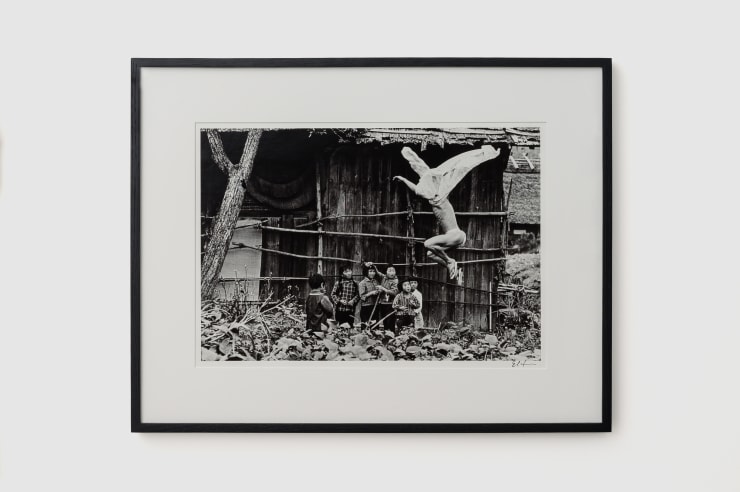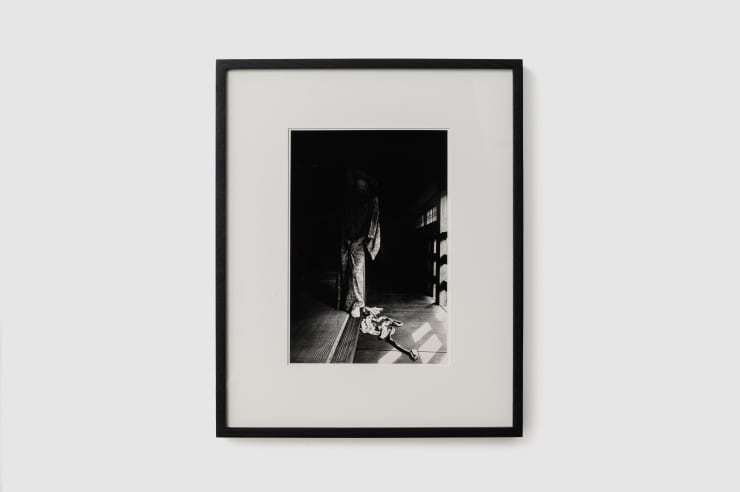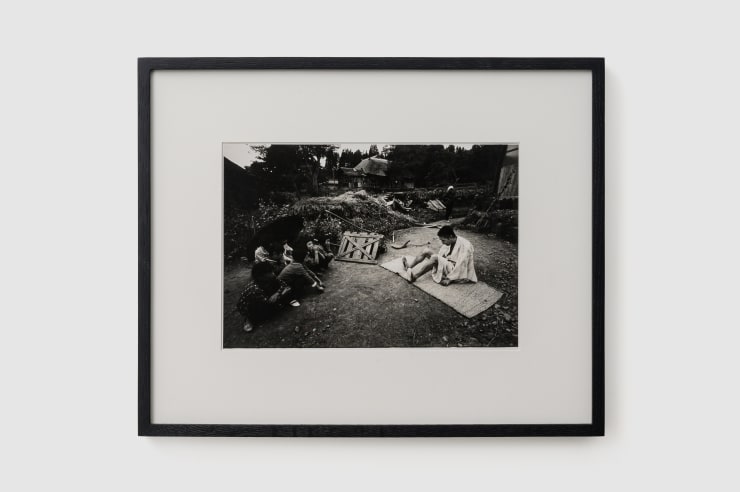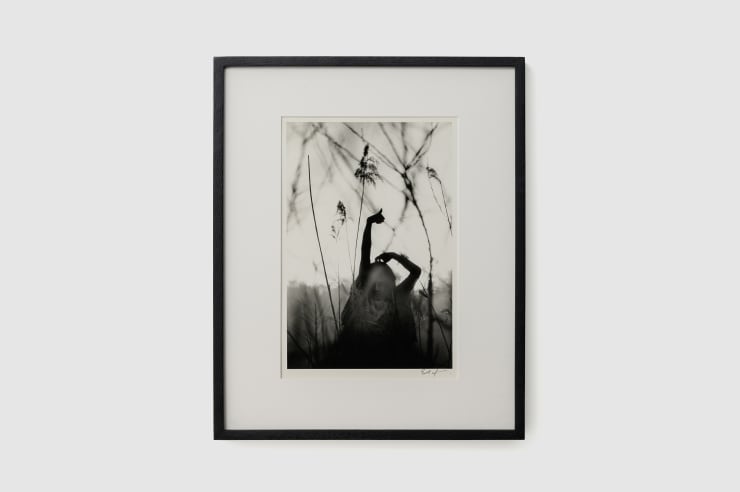Eikoh Hosoe: Collaborations with Tatsumi Hijikata
Press:
Hyperallergic, November 30, 2019
Art Viewer, November 19, 2019
Contemporary Art Review Los Angeles, November 13, 2019
Los Angeles Times, October 31, 2019
AUTRE, October 18, 2019
The celebrated photographer, Eikoh Hosoe (1933) was a long-time friend and collaborator of Tatsumi Hijikata, having first met in 1959 at Hijikata’s debut Ankoku Butoh performance, Forbidden Colors (Kinjiki), based on the novel by Yukio Mishima, with whom Hosoe would also create significant collaborations. Hosoe was then a member of the independent photo agency, VIVO along with Kikuji Kawada, Ikko Narahara, Akira Sato, Akira Tanno, Shomei Tomatsu. The VIVO photographers steered away from then popular objective realism towards a more subjective and expressive approach. In 1960, Hosoe founded the Jazz Film Laboratory (Jazzu Eiga Jikken-shitsu) to produce multi-disciplinary artworks. Featuring Tatsumi Hijikata in his early career, Hosoe’s intense black and white short film Navel and A-Bomb (Heso to genbaku), 1960 contemplates a new beginning provoked by the bombings of Hiroshima and Nagasaki.
As Japan urbanized in the economic boom period in the decades following WWII, Hosoe felt a growing sense of urgency to revisit the rural Tohoku region where he had been evacuated as a child to escape Tokyo air-raids. The photographer enlisted dancer Tatsumi Hijikata, who is from the same Tohoku region, to enact the "sickle-toothed weasel", a vicious god of local folklore and a threat that terrorized the young displaced Hosoe, who also associates his time in that region with an innocent happiness within an otherwise dark period. Hosoe said:
In the village, he played with children, was laughed at by farmers along the roadside, shat in the middle of a field, attacked a bride, kidnapped a baby, and ran through the rural landscape. Almost all the shooting was done guerrilla style in a flash. This was something that could only be achieved through photography. No other medium — film, television, painting, or novel — could have been used in its place. At that moment, I was certain of the superiority of photography.
Eikoh Hosoe, “Foreword” in Kamaitachi 1
Indeed, Hosoe’s high-contrast and theatrical photographs perfectly emphasized the corporeality of Hijikata’s impromptu performances. While exploring a shared affinity for a specific place, the artists co-created a suite of images, light-hearted and brooding, and abundant of metaphor. The Kamaitachi photographs(1965-1968) were published as a book by the same name in 1969, which has since been re-issued numerous times.
Eikoh Hosoe (1933 - ) is one of the best-known photographers of Japan's post-war era. His work has been the subject of numerous solo and group exhibitions in Japan and abroad, and is held in innumerable public collections. Hosoe is the recipient of several awards, including The Medal with Purple Ribbon (1998), The Royal Photographic Society (England) Special 150th Anniversary Medal Award (2003), The Order of the Rising Sun (2007), the Mainichi Art Award (2008), and was designated as a Person of Cultural Merit by the Ministry of Education in 2010. Since its opening in 1995, Hosoe has served as Director of The Kiyosato Museum of Photographic Arts, Hokuto, Yamanashi Prefecture, Japan.
1 Eikoh Hosoe, “Kamaitachi,” Shashin Hosoe Eikoh no sekai (Eikoh Hosoe Photographs 1951 – 1988), Shashin Hosoe Eikoh no sekaiten jikko iinkai, 1988
-
 Eikoh HosoeKamaitachi #31, 1968/2015Gelatin silver print.Image size: 12 x 17-13/16 inches
Eikoh HosoeKamaitachi #31, 1968/2015Gelatin silver print.Image size: 12 x 17-13/16 inches
Paper size: 16 x 19-15/16 inches
Frame size: 19-1/2 x 25 inches
Image size: 30.5 x 45.2 cm
Paper size: 40.6 x 50.5 cm
Frame size: 49.53 x 63.5 cm -
 Eikoh HosoeKamaitachi #14, 1965/ ca. 1970Gelatin silver printImage size: 8 x 11-3/4 inches
Eikoh HosoeKamaitachi #14, 1965/ ca. 1970Gelatin silver printImage size: 8 x 11-3/4 inches
Paper size: 9-15/16 x 12 inches
Frame size: 15 x 18-1/2 inches
Image size: 20.3 x 29.8 cm
Paper size: 25.2 x 30.5 cm
Frame size: 38.1 x 47 cm -
 Eikoh HosoeKamaitachi #17, 1965/2007Gelatin silver print.Image size: 12-1/4 x 17-13/16 inches
Eikoh HosoeKamaitachi #17, 1965/2007Gelatin silver print.Image size: 12-1/4 x 17-13/16 inches
Paper size: 16 x 19-15/16 inches
Frame size: 19-1/2 x 25 inches
Image size: 31 x 45.1 cm
Paper size: 40.5 x 50.5 cm
Frame size: 49.53 x 63.5 cm -
 Eikoh HosoeKamaitachi #37, 1965/2014Gelatin silver printImage size: 8-1/8 x 12 inches
Eikoh HosoeKamaitachi #37, 1965/2014Gelatin silver printImage size: 8-1/8 x 12 inches
Paper size: 11 x 14-1/16 inches
Frame size: 15 x 18-1/2 inches
Image size: 20.5 x 30.5 cm
Paper size: 27.9 x 35.6 cm
Frame size: 38.1 x 47 cm -
 Eikoh HosoeKamaitachi #19, 1965/ 2007Gelatin silver print.Image size: 12 x 17-13/16 inches
Eikoh HosoeKamaitachi #19, 1965/ 2007Gelatin silver print.Image size: 12 x 17-13/16 inches
Paper size: 16 x 19-15/16
Frame size: 19-1/2 x 25 inches
Image size: 30.4 x 45.2 cm
Paper size: 40.6 x 50.5 cm
Frame size: 49.53 x 63.5 cm -
 Eikoh HosoeKamaitachi #23 (large), 1965/2014Gelatin silver print.20 x 24 inches (print)
Eikoh HosoeKamaitachi #23 (large), 1965/2014Gelatin silver print.20 x 24 inches (print)
25 x 29 inches (framed, approx.) -
 Eikoh HosoeKamaitachi #13, 1965/2014Gelatin silver print.Image size: 8 x 12 inches
Eikoh HosoeKamaitachi #13, 1965/2014Gelatin silver print.Image size: 8 x 12 inches
Paper size: 11 x 14 inches
Frame size: 15 x 18-1/2 inches
Image size: 20.5 x 30.6 cm
Paper size: 27.9 x 35.6 cm
Frame size: 38.1 x 47 cm -
 Eikoh HosoeKamaitachi #3, 1965/ ca. 1970Gelatin silver printImage size: 8-1/4 x 11-13/16 inches
Eikoh HosoeKamaitachi #3, 1965/ ca. 1970Gelatin silver printImage size: 8-1/4 x 11-13/16 inches
Paper size: 11-15/16 x 10 inches
Frame size: 15 x 18-1/2 inches
Image size: 20.9 x 29.9 cm
Paper size: 30.3 x 25.3 cm
Frame size: 38.1 x 47 cm -
 Eikoh HosoeKamaitachi #25, 1965/ ca. 1970Gelatin silver printImage size: 11-1/2 x 7-3/4 inches
Eikoh HosoeKamaitachi #25, 1965/ ca. 1970Gelatin silver printImage size: 11-1/2 x 7-3/4 inches
Paper size: 11-15/16 x 10 inches
Frame size: 18-1/2 x 15 inches
Image size: 29.2 x 19.6 cm
Paper size: 30.3 x 25.4 cm
Frame size: 47 x 38.1 cm -
 Eikoh HosoeKamaitachi #20, 1965/ ca. 1970Gelatin silver printImage size: 11-3/4 x 7-7/8 inches
Eikoh HosoeKamaitachi #20, 1965/ ca. 1970Gelatin silver printImage size: 11-3/4 x 7-7/8 inches
Paper size: 12 x 10 inches
Frame size: 18-1/2 x 15 inches
Image size: 29.7 x 20 cm
Paper size: 30.4 x 25.4 cm
Frame size: 47 x 38.1 cm -
 Eikoh HosoeKamaitachi #18, 1965/ ca. 1970Gelatin silver printImage and paper size: 20.1 x 29.7 cm
Eikoh HosoeKamaitachi #18, 1965/ ca. 1970Gelatin silver printImage and paper size: 20.1 x 29.7 cm -
 Eikoh HosoeKamaitachi #11, 1965/ ca. 1970Gelatin silver printImage and paper size: 8-5/16 x 11-3/4 inches
Eikoh HosoeKamaitachi #11, 1965/ ca. 1970Gelatin silver printImage and paper size: 8-5/16 x 11-3/4 inches
Frame size: 15 x 18-1/2 inches
Image and paper size: 20.4 x 29.7 cm
Frame size: 38.1 x 47 cm -
 Eikoh HosoeKamaitachi #5, 1965/1989Gelatin silver print.Image size: 8 x 12 inches
Eikoh HosoeKamaitachi #5, 1965/1989Gelatin silver print.Image size: 8 x 12 inches
Paper size: 11 x 14 inches
Frame size: 15 x 18-1/2 inches
Image size: 20.3 x 30.4 cm
Paper size: 27.8 x 35.6 cm
Frame size: 38.1 x 47 cm -
 Eikoh HosoeKamaitachi #41, 1968/2013Gelatin silver print.Image size: 8-1/8 x 12 inches
Eikoh HosoeKamaitachi #41, 1968/2013Gelatin silver print.Image size: 8-1/8 x 12 inches
Paper size: 11 x 14-3/16 inches
Frame size: 15 x 18-1/2 inches
Image size: 20.4 x 30.4 cm
Paper size: 27.8 x 35.9 cm
Frame size: 38.1 x 47 cm -
 Eikoh HosoeKamaitachi #32, 1968/ ca. 1970Gelatin silver printImage Size: 7 3/4 x 11 3/8 in
Eikoh HosoeKamaitachi #32, 1968/ ca. 1970Gelatin silver printImage Size: 7 3/4 x 11 3/8 in
19.6 x 29 cm
Paper Size: 9 3/8 x 11 7/8 in
23.9 x 30.3 cm -
 Eikoh HosoeKamaitachi #34, 1965/1989Gelatin silver print.Image size: 12 x 8-1/16 inches
Eikoh HosoeKamaitachi #34, 1965/1989Gelatin silver print.Image size: 12 x 8-1/16 inches
Paper size: 13-15/16 x 11 inches
Frame size: 18-1/2 x 15 inches
Image size: 30.5 x 20.4 cm
Paper size: 35.3 x 27.9 cm
Frame size: 47 x 38.1 cm -
 Eikoh HosoeKamaitachi #9, 1965/ ca. 1970Gelatin silver printImage size: 11-1/2 x 7-3/4 inches
Eikoh HosoeKamaitachi #9, 1965/ ca. 1970Gelatin silver printImage size: 11-1/2 x 7-3/4 inches
Paper size: 12 x 10 inches
Frame size: 18-1/2 x 15 inches
Image size: 29.1 x 19.6 cm
Paper size: 30.4 x 25.4 cm
Frame size: 47 x 38.1 cm -
 Eikoh Hosoe“Embrace” #26, 1969Gelatin silver print.Image size: 8-1/2 x 5-3/4 inches (21.6 x 14.7 cm)
Eikoh Hosoe“Embrace” #26, 1969Gelatin silver print.Image size: 8-1/2 x 5-3/4 inches (21.6 x 14.7 cm)
Frame size: 16-9/16 x 12-5/8 inches (42 x 32 cm) -
 Eikoh Hosoe“Embrace” #29, 1969Gelatin silver print.Image size: 5-3/4 x 8-1/2 inches (14.6 x 21.7 cm)
Eikoh Hosoe“Embrace” #29, 1969Gelatin silver print.Image size: 5-3/4 x 8-1/2 inches (14.6 x 21.7 cm)
Frame size: 12-5/8 x 16-9/16 inches (32 x 42 cm) -
 Eikoh Hosoe"Embrace" #41, 1970Gelatin silver print.Image size: 9-1/2 x 6-7/16
Eikoh Hosoe"Embrace" #41, 1970Gelatin silver print.Image size: 9-1/2 x 6-7/16
Paper size: 9-15/16 x 8-1/8 inches
Image size: 24.0 x 16.3 cm
Paper size: 25.2 x 20.5 cm -
 Eikoh Hosoe"Embrace" #49, 1970Gelatin silver print.Image size: 7-5/8 x 11-7/16 inches
Eikoh Hosoe"Embrace" #49, 1970Gelatin silver print.Image size: 7-5/8 x 11-7/16 inches
Paper size: 10 x 12-3/16 inches
Image size: 19.3 x 29.0 cm
Paper size: 25.3 x 30.9 cm
































